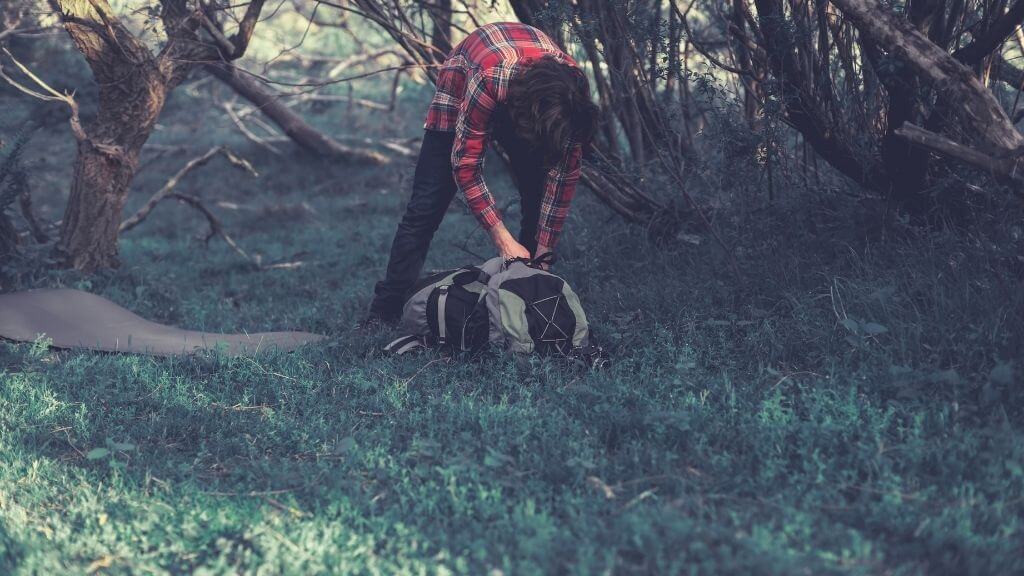Rucking is a form of physical exercise that is popular among military members and civilians alike. However, some people worry about the effects it will have on their back.
Many research studies have shown that rucking can be good for your back as long as you maintain a proper posture and don’t carry excessive weight.
Is Rucking Bad for Your Back?
Just like physical exercise, if you do not do it correctly, you can injure yourself.
If you carry an abnormal weight load, or even ruck improperly, rucking can be extremely agonizing for your spine. Incorrect compression of the ruck straps can cause nerve compression injury.
However, if you ruck with the proper posture, with an appropriate weight load, and you’re not susceptible to the compression from the ruck straps, rucking is not bad for your spine.
How to Avoid Back Pain and Injury While Rucking

When most people think of rucking, they associate it with military personnel who carry heavy backpacks during long marches. Rucking is an efficient way to build stamina, but in order to minimize the risk of injury, it must be performed properly.
Here are some tips and tricks to help you get rid of back pain while rucking:
Rucksacks are Important
Not every backpack makes a suitable rucksack. You need wide shoulder straps, also a chest or hip strap (maybe both). The ideal rucksack is one featuring an external frame that holds the weight.
When evaluating a good rucksack, looking for packs that are MOLLE (Modular Lightweight Load-Carrying Equipment) is a good direction. Molle packs let you assemble vital gear and customize it as your equipment and loadout change.
A bad rucksack can be the cause of your back pain. A study by PubMed (source) analyzing the difference between backpacks with shoulder straps that are non-flexible and flexible shoulder straps found some interesting things regarding the effect of straps on the way people walk.
They compared the consequences of both packs on participants’ muscle pain in their neck, shoulder, lumbar, upper, and lower leg muscles. Subsequently, they filled out a questionnaire to compare the pain level of both packs.
The results of this experiment demonstrated that the normal gait (the correct mechanics of walking) improved resulting in a more upright posture. It also indicated that the shoulder straps wider by approximately eight inches (optimal width) are better when carrying a heavy load.
As you carry a heavy load, better distribution of your weight, coupled with a padded backpack strap, offers optimal comfort.
If a rucksack is not loose, completely padded, and approximately 8 cm wide, it is optimal for preventing pain and nerve compression while rucking.
Adjust the Straps of Your Rucksack Properly
Make sure your shoulder strap is well padded and well fastened. Yet while on the ruck, make sure that you’re aware of the pain or stinging sensations around your shoulders and adjust your straps accordingly.
Constant pressure due to so many straps can cause numbness or blisters. If you do find yourself in that situation relax and take a short break. Try to lower the weight if you can.
Try a Hip Belt
Not all rucksacks have one but if yours does you have to use it.
Hip belts can distribute weight over the body effectively when used correctly; hip belts can reduce almost 30% of the weight you carry.
It enables you to move your weight to your legs, reducing the amount on your shoulders. Ensure that the straps are tight enough so it’s doing a good job keeping your backpack near you, but not too loose or uncomfortable.
Rucksack Management

It is possible that your belongings will need to be repositioned based on the ground you will stand on.
For example, when you ruck on flat terrain you can move your heavy items to the top. This will help you stand up straight. For non-flat terrain, you can evenly distribute heavy items in your rucksack so you are more stable.
Proper Posture
You don’t want to hunch your shoulders forward. Maintain them back and let your shoulders distribute the weight. Your body will want to lean forward to accommodate the added weight.
There is an easy acronym for you to remember in order to get the proper posture and that is S.E.L.F. Which stands for:
- Shoulders Back,
- Eyes Ahead,
- Lean SLIGHTLY,
- Feet Pointing Forward
Plan Out How You Can Progress
Start small and build yourself up. If you’re carrying too much weight, you’re in for an uncomfortable rucking experience. There’s no reason why a casual rucker needs to carry more than 30 pounds of weight to get the maximum benefit from his activity.
What to Do If You Still Have Back Pain
Are you concerned about rucking and the pressure it might put on your back? The pack’s weight is transferred to the lower spine and can result in back pain, muscle strain, and potential injury.
If you tried everything and still experiencing back pain you can:
Visit a Doctor
This is the best thing to do if you’re experiencing back pain from rucking. Evaluate your back muscles, ligaments, and joints
Find a professional physiotherapist and tell him what you are experiencing. He should be able to tell you what is the problem and how to fix it.
Try a Weighted Vest Instead of a Rucksack
You may want to consider using a weighted vest instead of a backpack. This could be a temporary solution, but a weighted vest could be a better alternative to a rucksack.
Due to the weight distribution being better centered in your body, you are less inclined to put excessive reliance on your back to lift that weight.
Conclusion
In conclusion, rucking has been proven to be a good form of exercise as long as ruckers understand the risks and work to mitigate them. By wearing a properly fitted backpack, using weight appropriately, and warming up before beginning, one can minimize the risk of injury.
Rucking is not bad for your back if you follow these guidelines.



